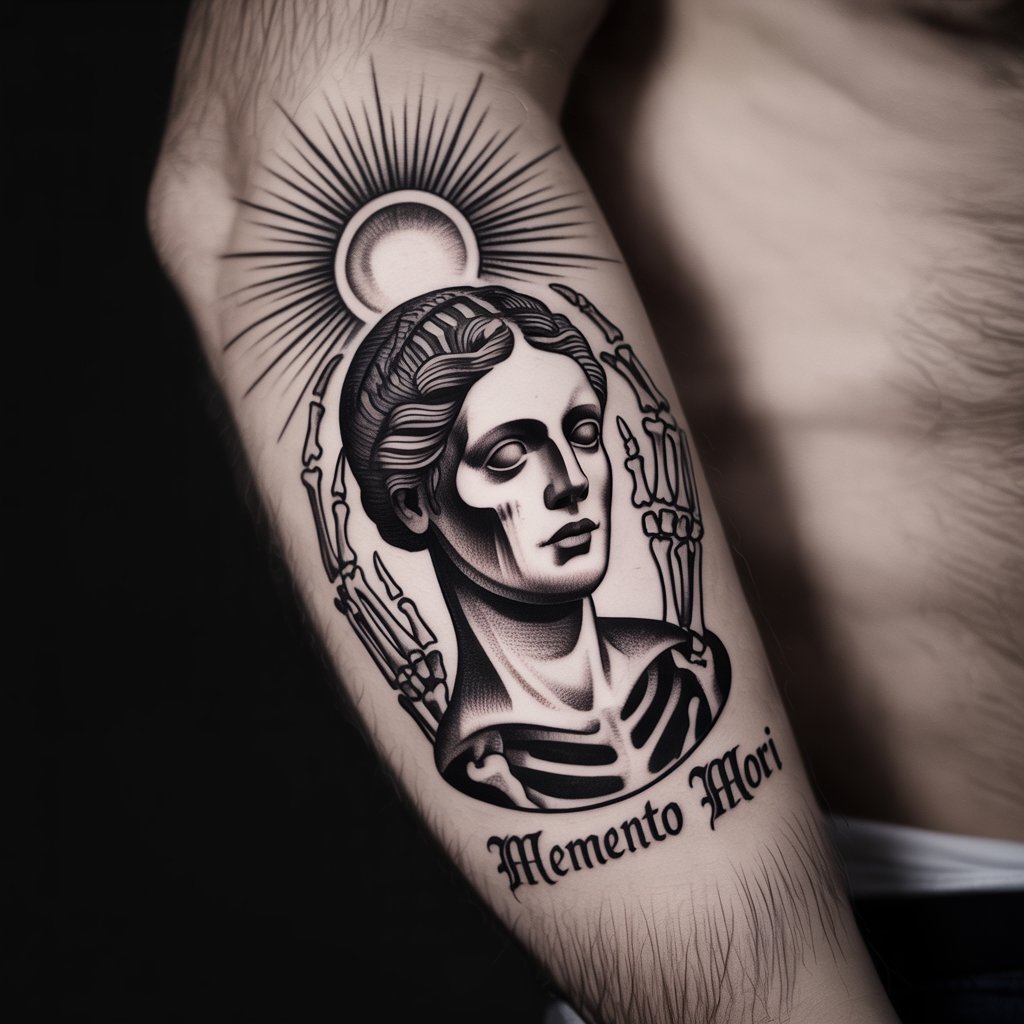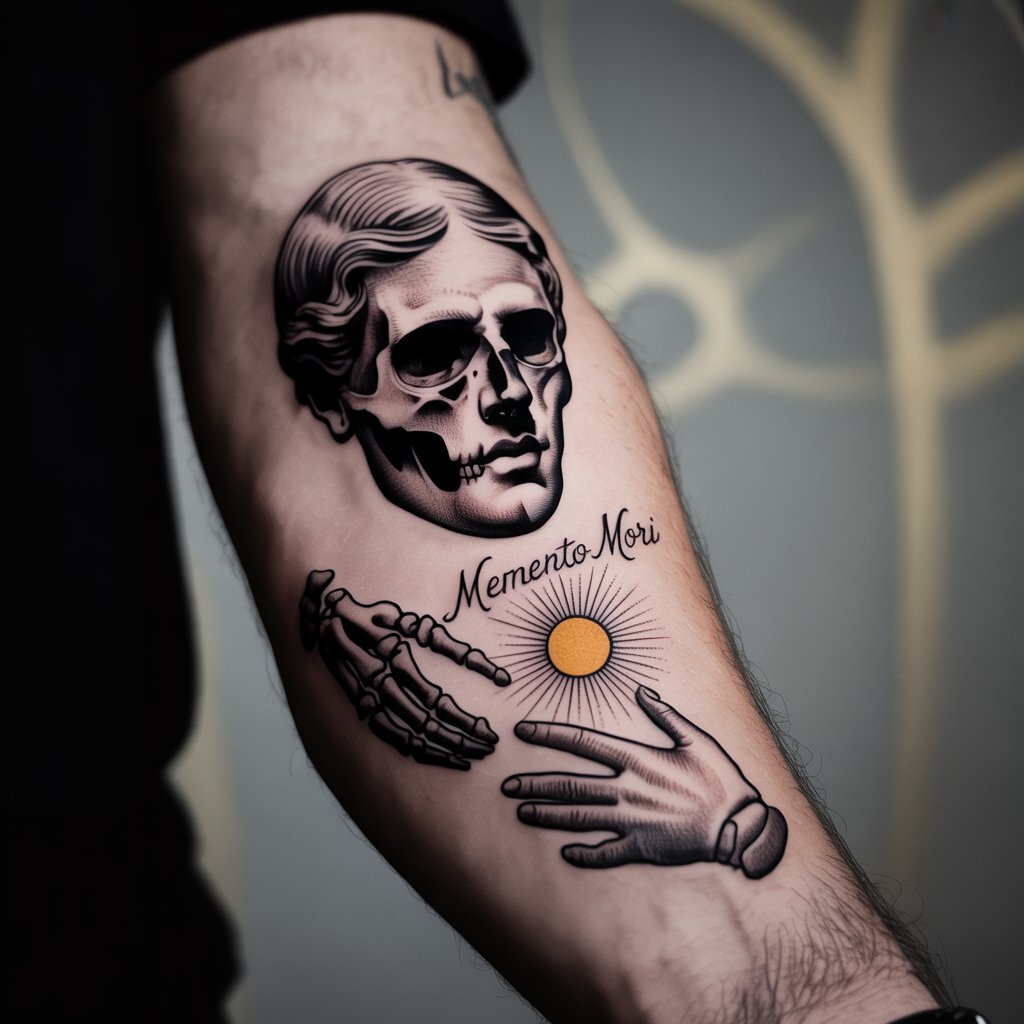In the rich tapestry of tattoo symbolism, few concepts carry the philosophical weight and artistic beauty of memento mori designs. These profound pieces—literally meaning “remember you must die”—transform the skin into a canvas for contemplating mortality, embracing life’s preciousness, and finding beauty in the inevitable. Far from morbid fascination, these tattoos represent one of humanity’s most ancient and universal themes rendered through contemporary artistic mastery.
The Classical Roots of Mortality Art
The memento mori tradition stretches back millennia, finding expression across cultures and artistic movements. In ancient Rome, servants would whisper “memento mori” to victorious generals during triumph parades, ensuring they remained humble amid glory. Renaissance artists incorporated skulls, hourglasses, and wilting flowers into their masterpieces as reminders of life’s transience.
“Modern memento mori tattoos connect us to this incredible artistic lineage,” explains art historian Dr. Catherine Mills. “When someone chooses these designs, they’re participating in a conversation about mortality that spans centuries and cultures. It’s simultaneously deeply personal and universally human.”
Contemporary memento mori tattoos often feature classical elements reimagined through modern tattooing techniques—Greek and Roman sculpture rendered in photorealistic detail, adorned with sunbursts, skeletal hands, and gothic lettering that bridges ancient wisdom with contemporary aesthetics.
The Psychology of Embracing Mortality
Choosing to permanently mark one’s body with imagery of death might seem paradoxical, but research suggests that contemplating mortality can actually enhance life satisfaction and meaning.
“Memento mori tattoos serve as daily reminders to live authentically,” notes existential psychologist Dr. James Reeves. “Rather than creating anxiety about death, they often help people prioritize what truly matters. There’s something profoundly liberating about accepting mortality—it can free us from trivial concerns and redirect focus toward meaningful experiences and relationships.”
This psychological framework explains why many memento mori tattoo recipients describe their pieces not as depressing reminders but as motivational anchors that encourage them to embrace life more fully.
Artistic Elements and Symbolic Language
The visual vocabulary of memento mori tattoos draws from centuries of established symbolism:
- Classical skulls: Often rendered with Roman or Greek aesthetic influences, representing the universality of death
- Hourglasses and timepieces: Symbolizing the passage of time and life’s finite duration
- Withering flowers: Particularly roses, representing beauty’s temporary nature
- Skeletal figures: Dancing skeletons or death personifications from medieval artistic traditions
- Latin phrases: “Memento Mori,” “Vanitas,” or other classical expressions of mortality themes
- Religious iconography: Angels, saints, or spiritual symbols addressing afterlife concepts
- Radiating light: Sun rays or halos suggesting transcendence beyond physical death
“The artistry lies in balancing these heavy themes with beautiful execution,” explains renowned tattoo artist Marcus Delacroix. “A well-executed memento mori piece should be simultaneously sobering and stunning—something that makes you pause and reflect while appreciating the craft involved.”

Cultural Variations and Modern Interpretations
While rooted in Western classical tradition, memento mori concepts appear across global cultures, each bringing unique artistic perspectives:
Mexican Day of the Dead influences introduce colorful sugar skull elements and celebration of death as part of life’s natural cycle. Gothic and Victorian aesthetics emphasize ornate details, mourning jewelry motifs, and romantic approaches to mortality. Japanese artistic traditions contribute concepts of mono no aware—the bittersweet awareness of impermanence—often expressed through cherry blossoms and seasonal imagery.
“What’s fascinating about contemporary memento mori tattoos is how they blend these various cultural approaches,” observes cultural anthropologist Dr. Elena Vasquez. “You might see a classical Roman portrait combined with Day of the Dead decorative elements and Japanese-inspired flowing lines. It creates something entirely new while honoring ancient traditions.”
The Technical Mastery Required
Creating compelling memento mori tattoos demands exceptional artistic skill across multiple techniques:
- Portrait work: Classical faces require precise anatomical knowledge and shading expertise
- Architectural elements: Columns, pedestals, and classical frameworks need perspective accuracy
- Texture differentiation: Distinguishing between marble, bone, fabric, and flesh textures
- Light and shadow dramatic work: Creating the chiaroscuro effects that give these pieces their emotional impact
- Typography integration: Incorporating classical lettering seamlessly into the overall composition
- Symbolic balance: Arranging multiple elements without creating visual chaos
“These pieces often take 15-25 hours to complete across multiple sessions,” notes veteran tattoo artist Sofia Chen. “The technical demands are enormous—you’re essentially creating a classical painting on living skin while incorporating various symbolic elements into a cohesive composition.”
Personal Meaning and Life Perspective
For many recipients, memento mori tattoos mark significant life transitions or philosophical realizations:
“I got my memento mori piece after surviving cancer,” shares tattoo recipient Maria Santos. “The experience taught me that acknowledging mortality doesn’t diminish life—it enhances it. Every morning when I see my tattoo, I’m reminded to make the day count.”
Others choose these designs to honor deceased loved ones, mark recovery from near-death experiences, or simply embrace philosophical perspectives that find beauty in life’s temporary nature.
The Paradox of Permanent Mortality Reminders
There’s beautiful irony in choosing permanent tattoos to represent temporary existence. While our physical forms are finite, the art that commemorates this truth becomes a lasting part of our time on earth.
“Memento mori tattoos create this wonderful paradox,” reflects tattoo historian Dr. Robert Klein. “They use permanent art to remind us of impermanence. In doing so, they become part of our legacy—something that outlasts our conscious awareness of mortality while continuing to carry the message forward.”
Considerations for the Contemplative Collector
Those considering memento mori tattoos should reflect deeply on their motivations and desired outcomes:
- Personal comfort with mortality themes: Ensure the imagery aligns with your psychological relationship with death
- Professional implications: Consider how classical death imagery might be perceived in various contexts
- Artistic commitment: These pieces typically require significant time and financial investment
- Placement considerations: Large pieces need adequate space for detailed classical elements
- Long-term meaning: Reflect on how these themes might resonate throughout your life journey
Living Fully Through Remembering Death
Perhaps the greatest paradox of memento mori tattoos is how remembering death can inspire fuller living. These powerful pieces serve as daily invitations to embrace authenticity, prioritize meaningful relationships, and find beauty in each moment’s preciousness.
In choosing to mark their bodies with reminders of mortality, wearers make a profound statement about life’s value. They declare that acknowledging death’s certainty doesn’t diminish existence—it illuminates what makes each day extraordinary.
As these classical themes continue finding new expression through contemporary tattoo artistry, memento mori pieces remind us that some truths transcend time and culture. Death may be universal, but so is the human capacity to find beauty, meaning, and motivation in contemplating our shared mortality.


